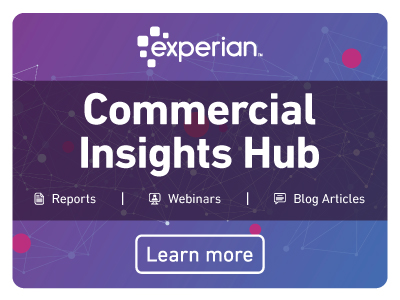All posts by Gary Stockton

By all indications, the supply chain challenge of this year will stretch well into 2022. Risk managers and finance departments are working in real-time to pivot, and keep customers satisfied, and while there’s currently no silver bullet to port delays, the lack of truck drivers or warehouse space, there are new strategies to consider. Join us for a very special supplier management webinar. Will your current suppliers be capable of delivering or do you need to pivot? In our upcoming webinar our panel of experts will talk about simplifying supplier discovery and diversification. In this talk you will learn: How to conduct a world-class supplier risk assessment program How to identify look-a-like suppliers in specific industries How to filter on multiple risk factors and more We will also be taking your questions, it promises to be an illuminating discussion, we hope you can join us. Register for Webinar

Experian hosted a commercial fraud trends webinar titled 'Uncovering Undiscovered Fraud Within The Portfolio'. During our session, key Experian experts Dominic DeGuiseppe, Javier Rodriguez-Paiva, and Li Mao, discussed the critical issue of commercial fraud within the financial industry and how it's often misclassified, leading to significant impacts on businesses. The speakers emphasized how businesses often underestimate their commercial fraud issues. Misclassification happens when business operational losses are erroneously categorized as credit losses. Businesses come to realize this when they delve deeper into the instances of credit misuse by fraudsters. Javier Rodriguez-Paiva argued that commercial fraud rates remain concerningly high, especially in small business lending and credit facilities, which are attractive magnets for criminals and credit abusers. This ongoing situation is worsened by lenders often lacking the specific capabilities to detect and manage fraud. In response to these challenges, Experian offers solutions aimed at rapid and early detection of different types of fraudulent activity. As Li Mao explained, the goal is to design solutions that allow businesses to identify risk quickly at the time of account opening, using advanced analytics and substantial data sources. Experian's solutions aim to ensure businesses can understand the different commercial fraud classifications and treat each case uniquely. By identifying the fraud type, be it first-party, third-party or synthetic ID fraud, appropriate responses can be triggered for each application. During the webinar, Li Mao introduced Experian's Multi-Point Verification solution, which verifies application information against trusted sources, allowing businesses to be confident of the identity of the business they are dealing with. This solution incorporates credit, fraud, and identity verification within a single tool. Javier Rodriguez-Paiva concluded by emphasizing the need for a more comprehensive risk management framework. Lenders could benefit from combining traditional credit scores with fraud-screening tools to provide a 360-degree view of a potential customer's risks. Such a multi-dimensional analysis can significantly improve fraud detection and prevention. The webinar highlighted Experian's commitment to supporting businesses in managing and mitigating prevalent commercial fraud challenges. While identity theft and credit abuse fraud are expected to increase, Experian's new strategies, enhanced verification tools, and advanced analytics solutions offer a promising shield against fraudulent activities. Click below to watch this webinar on-demand.
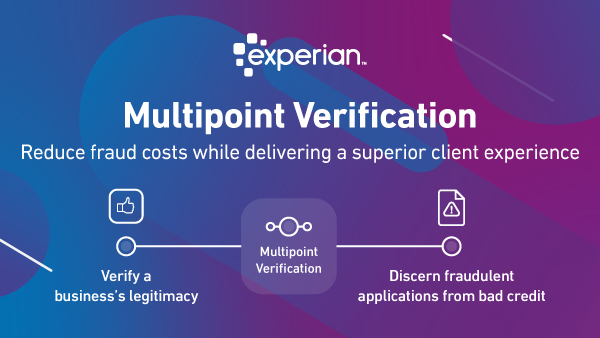
Experian is very excited to unleash game-changing commercial fraud detection capabilities with Multipoint Verification, a key component in our commercial fraud suite. Innovations in digital consumer experiences mean your commercial customers have new expectations. They want personalized, digital, secure faceless experiences, and fast decisions. But faster digital experiences without proper checks can often open the door to commercial fraud. Manual application reviews can slow things down, and cut into your bottom line. Experian can help you control costs and protect you from the high price of commercial fraud, and labor-intensive manual review processes. Multipoint Verification facilitates fraud detection at the point of application, so your lower-risk good customers can continue to enjoy a frictionless experience while you mitigate fraudulent applications. Introducing Experian Multipoint Verification Multipoint Verification helps you verify a business's legitimacy. In addition, it enables you to discern fraudulent applications from bad credit through comprehensive data sets. Single-sourced verification products can be limited in their capability and often prone to false positives. Multipoint Verification arms you with practical intelligence, so you can confirm the linkage between the applicant and claimed business, state filings, email issuance, or identify potential corporate linkage to other entities at the point of application. Experian is transforming the commercial fraud screening landscape, let’s start a conversation. Learn more about Experian Multipoint Verification
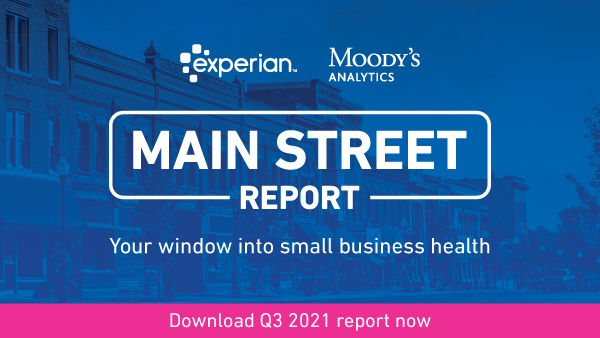
Experian and Moody's Analytics have just released the Q3 2021 Main Street Report. The report brings deep insight into the overall financial well-being of the small-business landscape and offers commentary on business credit trends and what they mean for lenders and small businesses. Labor shortages, wage pressure, and supply chain issues challenge small businesses Small business credit performance was mixed in the third quarter as businesses dealt with the COVID-19 Delta variant. Early-stage delinquency rates rose modestly while late state delinquency and bankruptcy rates fell decisively. With daily COVID cases falling, demand for goods and services should rise in coming quarters. Downside risks are concentrated on the supply side with businesses struggling to hire workers and dealing with supply chain stress. Early-stage delinquency rates rose in the third quarter with servicers reporting that 1.27% of small business credit balances were 31-90 days past due. While higher than the second quarter’s 1.19% rate, performance was only slightly worse than a year ago and significantly better than the pandemic high of 1.66%. Perhaps more notable was the sharp drop in late-stage delinquency, with 1.92% of balances reported as being more than 91 days past due. Supply chain issues are impacting both the availability and price of key inputs. Nowhere is this more apparent than in the semiconductor industry, where bottlenecks have shut down the manufacture of entire carlines. If you would like to get the full analysis of the data behind the latest Main Street Report, watch our Quarterly Business Credit Review webinar. Just scan the code or go to the short link and remember to download your copy of the latest report. Download Latest Report

For decades, lenders and others have relied on core credit data focused on financial borrowing and repayment behavior. Many factors go into the decision-making process, including the length of credit history, the number of open accounts, and on-time bill payments. What happens when a consumer or small business owner relies on cash for financial transactions or has never held a mortgage or a business loan? A significant portion of the U.S. adult population faces this problem. According to a 2020 report by the Federal Reserve, as many as 21 percent of U.S. consumers survive without a credit card. As a result, the traditional credit-scoring model doesn't tell the full story of their financial health, and they could be labeled “credit invisible" or “unscored" due to limited access to credit. It's both a personal and business problem. For consumers, that might mean not being able to secure a mortgage, insurance, or even be considered for a job. Start-ups and small businesses, meanwhile, may not be able to access credit to fuel their future growth and success. The recent explosion of new business filings brings the challenge of credit access to a head. Because small and emerging businesses can lack sufficient credit histories to qualify for credit on their own, they may rely on the owner's personal credit profile for lending decisions. Yet, some small businesses continue to struggle to get financing. It's especially pronounced in communities of color. For example, Black-owned businesses get turned down for bank financing at twice the rate that white-owned businesses do, according to the Federal Reserve. Source: Federal Reserve SBCS 2021 Report on Firms Owned by People of Color Technological innovations such as Experian's DataShare ™, Experian Boost and Social Media Insight are shaking up the conventional scoring system by bringing in alternative credit factors to fill out the credit picture. For lenders, the emergence of alternative data, otherwise known as non-traditional data, helps them make informed business credit decisions among a wider number of customers and prospects. What is non-traditional data? Traditionally, lending and other credit decisions have been based on factors such as credit history and on-time payments. That can allow people and businesses that do not have a lot of cash but can demonstrate good repayment behavior to borrow. However, it's quite another story when the situation is flipped. Some consumers and businesses don't utilize financial products, though they might have healthy cash flow. As a result, they lack the necessary data to generate a credit score, making them appear to be unattractive credit risks. Non-traditional data is an important way to give consumers access to better rates and open up borrowing to more consumers and businesses. This data can include things like rent and cell phone payments, giving lenders a broader range of information to consider. According to FinRegLab, 96 percent of U.S. households have a bank account or a prepaid card and 91 percent of U.S. adults have at least one utility account in their names. Overall, including other credit data, in addition to core credit data, would bring more people into the credit system. Including non-traditional forms of data can create financial inclusion for consumers and businesses. Where does non-traditional data come from? Non-traditional data is generated by aggregators that scour utility accounts, public records and property information to understand the financial activities of consumers. It considers a wider range of financial behaviors than what just appears on a credit report. These can include: - Rent payments - Utility payments - Employment verification - Bank account information, including recurring payroll deposits, average account balances and withdrawal activity. - Property records Non-traditional credit data goes one step further and supplements this data with information on consumers' use of alternative lending arrangements such as payday loans, small-dollar credit lenders, auto financiers, rent-to-own, retail financing, and others. Commercial lenders can also take advantage of technological innovations to gather non-traditional data for lending decisions, which can drive more approvals and greater profits. For businesses, non-traditional credit data can include: - Social media: How many user check-ins and reviews is a business getting on social media? That can say a lot about its business. Experian Social Media Insight™ provides a social media view to help lenders better score business borrowers with thin credit profiles. - Online financial activity: An uptick in PayPal or Venmo transactions can suggest healthy cash flow. - Bank details: Borrowers can permit lenders to view their business banking account, which shows how much cash on hand they have. - Accounting software: With direct access to QuickBooks or FreshBooks, lenders can make determinations about a potential customer's financial health in real-time. - Shipping information: For businesses moving products, analyzing shipping data allows lenders to make assumptions on cash flow. How is non-traditional data currently used? Financial institutions have become receptive to other credit data sources to provide additional insights. That can improve the accuracy of credit scoring and allow lenders to find more creditworthy consumers. According to Experian's 2020 State of Alternative Credit Data report, 96 percent of lenders believe that during times of economic stress, non-traditional credit data allows them to more closely evaluate consumers' creditworthiness and reduce their credit risk exposure. By deeming more consumers creditworthy, financial institutions can increase financial inclusion, while uncovering new lending opportunities for themselves. Modern tools make that possible. For example, Experian's Clarity Services provides insights on more than 62 million U.S. consumers, helping lenders better assess and manage risk. Lenders can see consumers' utilization of alternative finance and payment behaviors for a more holistic view of their creditworthiness. Likewise, Experian's DataShare™ is a non-traditional digital solution, which can be used to make commercial lending decisions. It provides owner-permissioned data to expedite new client onboarding and increase retention by bringing digital transformation to document gathering. With real-time financial data, lenders can understand the trends in their customers' financial positions to better assess risk. How can non-traditional data be used to calculate credit risk? Non-traditional credit data can help lenders gain deeper insights into their borrowers to better assess risk. For starters, it allows them to spot creditworthiness trends in real-time, rather than a snapshot in time that traditional credit data typically provides. A deteriorating financial position among prime customers and signs of improvement among marginal customers can be spotted faster with a combination of traditional and non-traditional data. Also, some consumers may appear to be “risky" through the lens of core credit data but may prove less so when non-traditional data points are included. For example, according to FinRegLab research, cash flow data can be predictive of credit risk, not just credit utilization and history. Owner-permissioned data lets consumers decide what lenders can see when making their credit determinations. For instance, lenders who use only traditional data might see an account that has been turned over to collections. With owner-permissioned data, on the other hand, a lender can also see a record of paying rent and cell phone bills on time. As a result, lenders can evaluate both types of behaviors in their credit decision, providing them with a fuller picture. Looking at how consumers leverage alternative financial products to manage debt can also reveal responsible credit-management behaviors. Consumers who appear to be low-risk in the eyes of traditional credit data may actually be riskier if they do not manage their alternative finance products well – an activity that doesn't appear on most credit reports. The challenges of non-traditional credit data Non-traditional credit data has the potential to open the world of credit to underserved communities. For lenders, it can unlock opportunities by bringing in a wider range of potential customers. But it's important to recognize that there are challenges too. For starters, lenders are still figuring out how to incorporate it into their lending decisions. While non-traditional credit data has always been available, big data collection now makes it easier to access. As lenders and regulators become more comfortable with its use, they will begin to incorporate it into credit decisions, while also being aware of its limitations. Consumers, meanwhile, may have data security and privacy concerns about how their information will be used and who may have access to it. The Consumer Financial Protection Bureau is working on guidelines that ensure that lenders are using data appropriately and fairly. Taking the next step Ready to see how non-traditional credit data can drive more business while also reaching your diversity, equity and inclusion goals? Modern tools simplify the process and bring a more holistic view to inform the lending decision. Learn more about how you can expand your customer base and improve profitability with non-traditional credit data. Learn more about Experian DataShare Related Articles Alternative data can help to facilitate small business lending Beyond Credit Risk - Understanding Alternative Data Bid Alternatives: How New Data Sources are Reshaping Online Lending
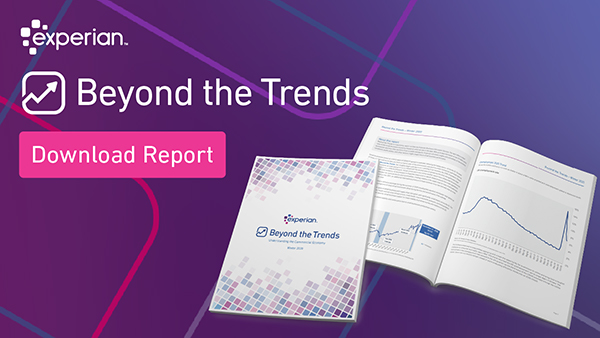
The Beyond The Trends Report - Fall 2021 Out Now! Did you know that there are about a million restaurants in the U.S? And those restaurants employ nine million people? As we prepared the latest Beyond the Trends report for Fall 2021, I took a deep dive into the restaurant industry in our small business data set to explore how restaurants were performing through the pandemic and how resilient they are now. Here's a quick snippet — the SBA's Restaurant Revitalization fund delivered 74,498 grants accounting for $22.4B in funds for May through June of 2021. It's a shot in the arm for restaurants. Here's how the funds were distributed based on annual sales. Distribution of Restaurants by Annual Sales Size source: SBA, Experian The RRF program has done well servicing a diverse set of applicants and underserved community segments. The Women-owned businesses made up almost half of the recipients Veteran-owned businesses were only 5% of the program. Veterans received fewer loans overall but had much higher average loan amounts awarded Restaurants in LMI designated areas were over a quarter of the program Restaurants in lower socioeconomic areas were over a third of the program's recipients Would you like to learn about this and other trends impacting small business? Download the Fall 2021 Beyond The Trends Report! Download the Latest Report
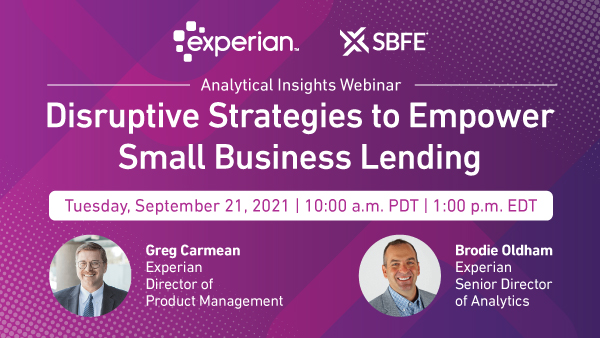
Gain the ability to identify the most stable and profitable small business clients Join our webinar, in partnership with the Small Business Financial Exchange (SBFE): Disruptive Strategies to Empower Small Business Lending Tuesday, September 21, 2021, 10:00 a.m. PDT | 1:00 p.m. EDT Learn how to target small business growth opportunities and enhance the customer experience through automated credit-risk decisioning, with special focus on: Advanced methodologies for developing and leveraging new data attributes Advantages to having explainable, machine-learned models Effortless data visualization to conceptualize growth opportunities Ability to target populations and product mix for financial inclusion Register for Webinar
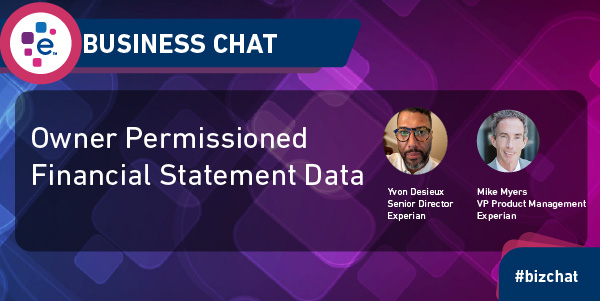
Subscribe To Our YouTube Channel [Gary]: I'm joined by Yvon Desieux, a Senior Director in our product team, and Yvon is responsible for product strategy and driving innovation in lending through the creation of products and applications for commercial lenders. Sitting next to Yvon is Mike Myers, our Vice President of Product Management here in Business Information, and he leads the product team and AgileWorks Innovation Lab. Welcome to Business Chat, gentlemen. The COVID-19 pandemic spurred a wave of innovation in e-commerce, in restaurant delivery services, in FinTech, digital has raised the stakes. There's an expectation with consumers and businesses that client experiences should be on an even playing field across industries. But when it comes to applying for loans, particularly on the commercial side, those processes can be quite manual. One of the things that speed things along is real-time, financial statement data. What is real-time financial statement data? [Yvon]: Well, simply, financial statement data in real-time is just when lenders are able to access accounting software via the Internet, to power their lending decisions, and our new product offering Experian Datashare, provides this capability with the power of owner permission data. With this permissioning, small business owners are empowered with the ability to leverage their own financial data, to apply for the loans and other services that they need. So, unlike a credit report, permissioning puts the owner in control of what transactional data they share, to qualify for the loans and lines of credit that they need to keep their businesses running. So this consented data provides personalization balanced with privacy for businesses and growth, balanced with accountability for the lenders. What problem is real-time financial statement data solving for lenders? [Yvon]: The feedback that we've received falls into four-tier categories. It's revenue growth creating operational efficiencies, decreasing risk, and creating a better client experience through a modern digital journey that's easy to understand and delivers faster decisions and quicker access to the financing that the small businesses need. Mike, when you talk to clients about digital transformation, what are the things that are keeping them up at night? What are they most concerned with? [Mike]: I think all of our clients, to some degree, are going through a technical transformation, or we often call a path to modernization, and Experian is in the same boat. You know, it's hard to stay on top of technology and really leverage the cloud and be able to get new products, new services, new capabilities to market quickly. Some of the biggest challenges our clients expressed to us are how do we operate in what's become a very different environment over the last year, year, and a half with COVID. Things have moved at a much more rapid pace, as far as digitization. So the interactions with their clients have changed. It's become a bit more impersonal. It's become a bit more quick and with a sense of urgency, and many clients are struggling to do everything online and do it at a breakneck speed. This is often where API's and with different technologies, we can keep pace and help our clients integrate data, access data, and ultimately render decisions to their end-users in a much quicker and more time-efficient way. Can you talk a little bit about Experian's API Hub and getting access to our data? [Mike]: The API economy has been here for many years, and our clients are integrating our data and, you know, putting it into their systems so their users can access data real-time. And Datashare is one of those services where this data can be integrated into our client's systems. And there's no drop-off, there's no manual, or swivel chair type activity where you're going to multiple systems. It becomes a much more efficient process. And not only the client wins, but also an applicant gets a much more rapid decision and can go ahead and power their business. Can financial statement data play a role in helping emerging and underserved businesses grow? If so, how? [Yvon]: Yeah, for new and small businesses that haven't yet established business credit and rely on the owner's personal credit profile for lending decisions, Datashare gives them the ability to share their financial statements and show the financial health of the business. This expanded data can be used, in the decision-making process in addition to the standard bureau data to create more approvals. By permissioning data, these businesses are able to move out of an unscorable or subprime, hard money loan bracket, into a space that helps them qualify for more traditional loans and lines of credit, with better rates in terms. [Gary]: Mike, I've got another slide here; businesses of color, have been severely impacted by COVID. You can see some of these stats here. 30% of black business owners say that access to credit is the biggest challenge in the next 12 months. 47% said they didn't apply for financing because they did not think they would be approved, only 37% received all of the financing they sought. Recently on a CBA webinar with a Experian, Janelle Williams from the Atlanta Fed was saying that 83% of the PPP loans went to white-owned businesses, but only 1.9% went to businesses of color. How can Experian DataShare help underserved businesses of color? [Mike]: Yeah, Gary, you're really touching on a key point here. You know, small businesses, power our economy. They make up the majority of businesses out there. And based on that recent stat you and Yvon just discussed about new business startups. There's more than ever, and we all have to do a better job of making sure there's an equal playing field when it comes to accessing capital, whether it's trade credit or financial packages, to help them manage their cash flow. And that became more evident than ever again, with the pandemic and the sudden shift in the economy. It became more and more challenging for many small businesses to manage their cash flow, pay their employees, and really see a path forward. So data share is exciting in a number of ways. What excites me is that it now combines a historical process that was done in a much more offline manual way. And now can be done in real-time. And if you start combining that with historical payment information, historical public record filings, in addition to real-time financials, you have a winning combination that can provide a clear view of a small business's financial status and real-time view. So not only the historical, which is a great way to predict future payment behavior, but also the most current accounts receivable accounts payable information that can really help you understand what their future holds. How can DataShare deepen the relationships between lenders and the small businesses that they serve? [Yvon]: Datashare drives operational efficiency. So, it allows the lenders to receive the financial statement data in a standardized format. This is regardless of the size of the business or the source of the accounting data. It drastically reduces the level of manual effort required to underwrite a loan. And it automates much of the time spent on the administrative tasks associated with the lending process. So this means that relationship managers and underwriters and credit teams are going to spend less time creating reports and gathering documents and chasing clients. And they're going to be able to spend more time holding, we hope, value-driven conversations to deepen the relationships they have with their clients and help those businesses grow and expand in line with their needs. [Gary]: So those small businesses are going to experience greater efficiency, ease of doing business with their lender. The lender has more time to devote and work more closely with those clients, but also maybe the underserved businesses, the unscored businesses, they have that additional insight to see really how that business is doing and how they can grow that relationship with them. Am I right? [Yvon]: Yeah, absolutely. Time is the big commodity, and speed kills. So what Datashare allows lenders to do is negate all of the wasted time and effort spent onboarding and processing clients. And they can dig into that live transactional data, and get to understand the business, and perhaps share insights with the business owners that even the owners don't know. So, it allows both sides to work more efficiently and more profitably. [Gary]: Are you seeing a change in perception on the part of the business owners of today? I mean, a lot of the Millennial business owners they're used to mobile technology, they're used to delivery services on-demand services. Do you see a change in perception in permissioning, access to financial statement data? [Yvon]: Yeah, actually, we have. We typically see adoption rates as high as 90% when it comes to small businesses that are actively looking for financing. So these are motivated clients who typically go with a lender that can provide the quickest time to cash, and Datashare typically cuts down that time to about 65%. We live in a rapidly developing world where digital adoption is at an all-time high, and the same is true for small businesses. As we shift from the stacks of paper and filing cabinets, both lenders and borrowers see the benefits of leveraging technology to make their organizations more efficient and profitable. The annual review process is one pain point that we've heard a lot from clients. Is this something that could help clients minimize some of that pressure, that's a real stressor on bandwidth? [Yvon]: Yeah, absolutely. Datashare automates the monthly, quarterly, or annual review process. So when a small business permissions their data, lenders are able to choose the data refresh frequency, that is also permissioned. So, combined with covenant monitoring Datashare is able to flag accounts that fall out of an agreed risk threshold, which saves the credit team valuable time having to review their entire book of business and allows them to strategically focus on problem accounts and mitigate risk before it gets out of hand. [Gary]: So, any further thoughts on how Experian DataShare can help lenders or the small businesses they serve? [Yvon]: Yeah. Our focus will continue to be on finding ways to automate processes and provide insights into the financial statement data that we acquire. We'll continue to receive feedback from the clients that we've partnered with and integrate that into our roadmap to create new products and services that will benefit both lenders and the borrowers that they serve. [Mike]: Yeah. I would add Gary that we're at a really interesting time. You know, there's the speed and the in-depth view of a small business's financials at our client's fingertips that can help equal that playing field and open up financial opportunities for businesses of all shapes, sizes, and colors, and Experian Datashare helps with that. Combine that with our historical trade and public record data, and you've got a winning solution for both our clients who are offering the financial vehicles, as well as the applicants, the small businesses out there that need help. And that historically may have been on the outside looking in. Now they have an opportunity to share their financial situation, a picture that can help them move their business forward and access capital when they most need it. [Gary]: Well, this has been super informative, guys. I want to thank you for taking the time to come on Business Chat. And if you would like to learn more about how real-time financial statement data can help small businesses, Experian recently published a free ebook perspective paper. We'll provide a link and a QR code for you to download. If you have any questions, of course, feel free to reach out to your Experian account representative to get a conversation started about helping small businesses grow through innovative solutions like Experian DataShare. Thank you very much, gentlemen. Download Perspective Paper Learn more about alternative data
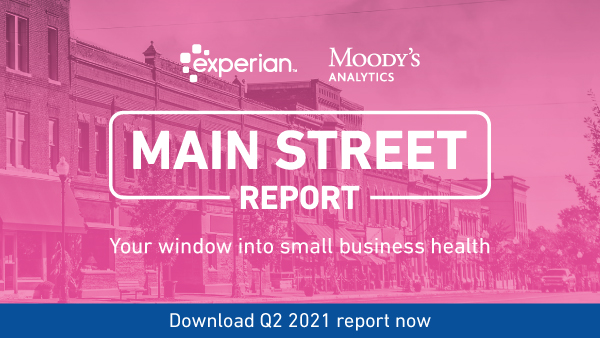
Q2 2021 Main Street Report Highlights Experian and Moody's Analytics have just released the Q2 2021 Main Street Report. The report brings deep insight into the overall financial well-being of the small-business landscape and offers commentary on business credit trends and what they mean for lenders and small businesses. Here are a few highlights: Price increases and supply chain issues persist The labor shortage is driving wage growth in some industries GDP grew at 6.5 percent As some industries struggle to contain price increases and to survive in a post-pandemic world, others are thriving on the back of economic reopenings driving consumption. Reopenings and pent-up demand for services are pushing up economic growth and powering a robust economic recovery. Moderately delinquent small business credit, defined as 31-90 days past due (DPD), moved down in the second quarter to 1.19 percent. But severe delinquency moved higher in the second quarter to 2.35 percent. After a long period of decline, this upward movement in severe delinquency rates is the largest in the post-recession period. Rising costs is becoming a factor among small businesses as they service their credit obligations. In the most recent NFIB survey, 39 percent of respondents indicated they were raising wages. If we break this down, we can see that wages are rising at double-digit rates in industries, such as leisure and hospitality. And this could spell trouble on the horizon in some sectors, as employers fight to control expenses. Real GDP grew at an annualized rate of 6.5 percent in the second quarter, led by consumption. The rapid rebound from Covid-driven shutdowns sustained the rapid economic growth of the second quarter as stimulus continued and vaccination rates increased. Join us for a deep dive If you would like to get the full analysis of the data behind the latest Main Street Report, watch our Quarterly Business Credit Review webinar. Just scan the code or go to the short link and remember to download your copy of the latest report. Download Q2 Report
